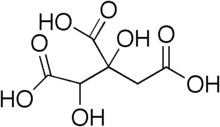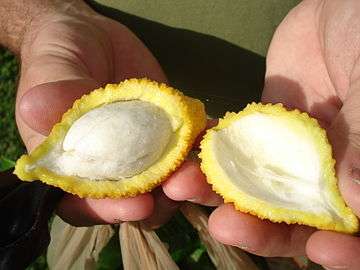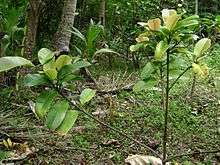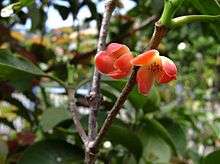Garcinia
Garcinia is a genus of flowering plants in the family Clusiaceae native to Asia, America, Australia, tropical and southern Africa, and Polynesia. The number of species is disputed; the Kew Gardens recognise up to 400.[1] Commonly, the plants in this genus are called saptrees, mangosteens (which may also refer specifically to Garcinia mangostana), garcinias, or monkey fruit.
| Garcinia | |
|---|---|
.jpg) | |
| Garcinia subelliptica, the fukugi tree | |
| Scientific classification | |
| Kingdom: | Plantae |
| Clade: | Tracheophytes |
| Clade: | Angiosperms |
| Clade: | Eudicots |
| Clade: | Rosids |
| Order: | Malpighiales |
| Family: | Clusiaceae |
| Tribe: | Garcinieae |
| Genus: | Garcinia L. |
| Synonyms | |
Many species are threatened by habitat destruction, and at least one species, G. cadelliana, from South Andaman Island, is almost or even completely extinct already.[2]
The fruits are a food source for several animals, such as the archduke butterflies (Lexias spp.) of tropical eastern Asia which relish the sap of overripe mangosteens.
Description
Garcinia species are evergreen trees and shrubs, dioecious and in several cases apomictic. The fruit is a berry with fleshy endocarp,[3] which in several species is delicious. Among neotropical Garcinia several species are dioecious (G. leptophylla, G. macrophylla and G. magnifolia), although female trees have often been observed to have some degree of self-fertility.
Uses

The fruit of most species of Garcinia are eaten locally; some species' fruits are highly esteemed in one region, but unknown just a few hundred kilometres away. The best-known species is Garcinia mangostana, which is now cultivated throughout Southeast Asia and other tropical countries, having become established in the late 20th century. Less well-known, but still of international importance, are kandis (G. forbesii) with small round red fruits with subacid taste and melting flesh, the lemon drop mangosteen (G. intermedia) with yellow fruit that look like a wrinkled lemon, and the thin-skinned orange button mangosteen (G. prainiana).
In addition, mangosteen rind (exocarp) extract is used as a spice. It figures prominently in Kodava culture, and G. multiflora is used to flavour and colour the famous bún riêu soup of Vietnam, where this plant is known as hạt điều màu. Garcinia gummi-gutta yields a spice widely used in South Asia, in particular in Kerala, where it is called kodumpulli.
Most species in Garcinia are known for their gum resin, brownish-yellow from xanthonoids such as mangostin, and used as purgative or cathartic, but most frequently – at least in former times – as a pigment. The colour term gamboge refers to this pigment.
Extracts of the exocarp of certain species – typically G. gummi-gutta, but also G. mangostana – are often contained in appetite suppressants, but their effectiveness at normal consumption levels is unproven, while at least one case of severe acidosis caused by long-term consumption of such products has been documented.[4] Furthermore, they may contain significant amounts of hydroxycitric acid, which is somewhat toxic and might even destroy the testicles after prolonged use.[5]
Bitter kola (G. kola) seeds are used in folk medicine.[6] G. mannii is popular as a chew stick in western Africa,[7] freshening the breath and cleaning the teeth.
G. subelliptica, called fukugi in Japanese, is the floral emblem of Mobuto and Tarama on Okinawa. The Malaysian town of Beruas – often spelled "Bruas" – derives its name from the seashore mangosteen (G. hombroniana), known locally as pokok bruas. It has been used for many years by certain African tribes as a tonic believed to increase 'energy levels' and to possess digestive and fat-busting properties.
 Garcinia mangostana (purple mangosteen) with white, edible endocarp
Garcinia mangostana (purple mangosteen) with white, edible endocarp Garcinia gardneriana (bacupari)
Garcinia gardneriana (bacupari)
Species


As of December 2018, Kew's Plants of the World Online lists nearly 400 accepted species.[1] Selected species include:
- Garcinia acutifolia
- Garcinia afzelii
- Garcinia aristata
- Garcinia assamica
- Garcinia atroviridis – asam gelugur (Indonesian), asam gelugor (Malaysian), asam keping (Malaysian)
- Garcinia benthamiana – asashi
- Garcinia bifasciculata
- Garcinia brasiliensis – bacupari-mirim
- Garcinia brevipedicellata
- Garcinia burkillii
- Garcinia cadelliana
- Garcinia cantleyana
- Garcinia celebica L.
- Garcinia clusiaefolia
- Garcinia costata
- Garcinia decussata
- Garcinia diversifolia
- Garcinia dulcis – mundu, rata
- Garcinia echinocarpa
- Garcinia epunctata
- Garcinia eugeniaefolia
- Garcinia gardneriana – bacupari
- Garcinia gummi-gutta – gambooge, garcinia cambogia, brindleberry, brindall berry, Malabar tamarind
- Garcinia hanburyi – Hanbury's garcinia
- Garcinia hendersoniana
- Garcinia hermonii
- Garcinia holttumii
- Garcinia humilis – achachairú, achacha
- Garcinia imberti
- Garcinia indica – wild mangosteen,
- Garcinia intermedia – lemon drop mangosteen, machare
- Garcinia kingii
- Garcinia kola – bitter kola
- Garcinia linii
- Garcinia livingstonei – African mangosteen, Lowveld mangosteen, Livingstone's garcinia, imbe
- Garcinia loureiroi - (Khmer: សណ្ដាន់)
- Garcinia macrophylla – pungara
- Garcinia madruno (Kunth) Hammel – charichuelo
- Garcinia magnifolia – bebasajo
- Garcinia maingayi
- Garcinia mangostana – purple mangosteen
- Garcinia minutiflora
- Garcinia monantha
- Garcinia montana
- Garcinia morella – batuan (Hiligaynon), ireevalsinni (Tamil)
- Garcinia multiflora Champ. – hạt điều màu (Vietnamese)
- Garcinia murtonii
- Garcinia nigrolineata Planch. ex T.Anderson
- Garcinia oliveri
- Garcinia opaca
- Garcinia paucinervis
- Garcinia pedunculata
- Garcinia prainiana – button mangosteen, cherapu
- Garcinia pushpangadaniana
- Garcinia pyrifera
- Garcinia quaesita
- Garcinia rubro-echinata
- Garcinia scortechinii
- Garcinia semseii
- Garcinia sessilis Seem. – heilala (Tongan), seilala (Samoan)
- Garcinia spicata
- Garcinia staudtii
- Garcinia terpnophylla
- Garcinia thwaitesii
- Garcinia travancorica
- Garcinia uniflora
- Garcinia warrenii F.Muell.
- Garcinia wightii
- Garcinia xanthochymus – yellow mangosteen, gamboge
- Garcinia zeylanica
References
- "Garcinia L." Plants of the World Online. Royal Botanical Gardens Kew. Retrieved 21 December 2018.
- World Conservation Monitoring Centre (1998). "Garcinia cadelliana". IUCN Red List of Threatened Species. 1998: e.T33490A9782233. doi:10.2305/IUCN.UK.1998.RLTS.T33490A9782233.en. Retrieved 12 January 2018.
- Asinelli, M.E.C.; Souza, M.C.o.d.; Mourao, K.t.S.M. (2011). "Fruit ontogeny of Garcinia gardneriana (Planch. & Triana) Zappi (Clusiaceae)". Acta Botanica Brasilica. 25 (43–52).
- Wong, Leslie P; Klemmer, Philip J (2008). "Severe Lactic Acidosis Associated with Juice of the Mangosteen Fruit Garcinia mangostana". American Journal of Kidney Diseases. 51 (5): 829. doi:10.1053/j.ajkd.2007.12.043. PMID 18436094.
- Saito, M; Ueno, M; Ogino, S; Kubo, K; Nagata, J; Takeuchi, M (2005). "High dose of Garcinia cambogia is effective in suppressing fat accumulation in developing male Zucker obese rats, but highly toxic to the testis". Food and Chemical Toxicology. 43 (3): 411–9. doi:10.1016/j.fct.2004.11.008. PMID 15680676.
- 20 Super Health Benefits Of Eating Bitter Kola (Garcinia Kola)
- Cheek, M. (2004). "Garcinia kola". IUCN Red List of Threatened Species. 2004: e.T34715A9884648. doi:10.2305/IUCN.UK.2004.RLTS.T34715A9884648.en. Retrieved 12 January 2018.